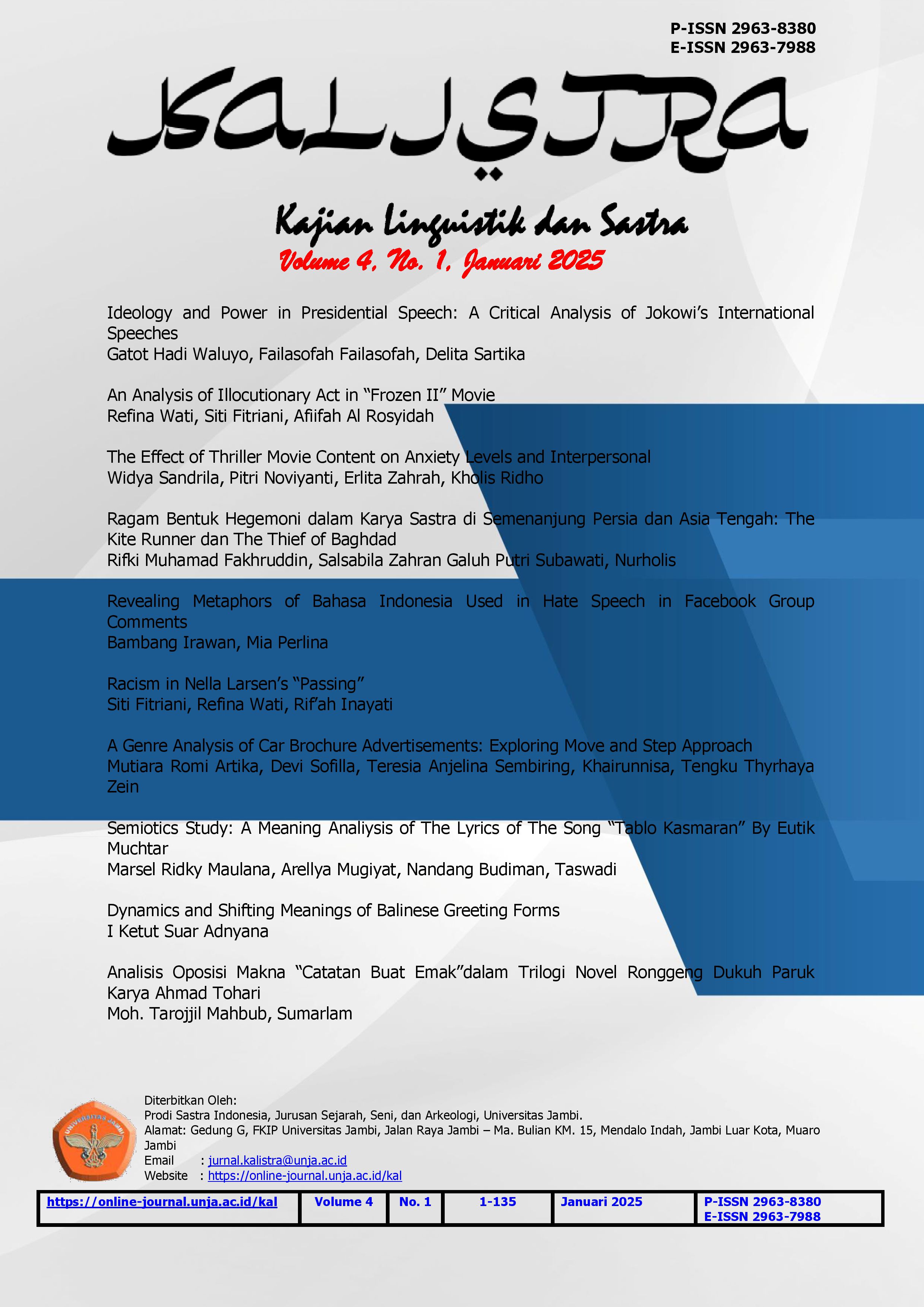Metafora dalam Serial Netflix Gadis Kretek: Kajian Semantik
DOI:
https://doi.org/10.22437/kalistra.v4i1.44859Keywords:
Semantic, Metaphor, Gadis KretekAbstract
Artikel ini membahas mengenai metafora di dalam serial Netflix Gadis Kretek dengan menggunakan teori milik Lakoff dan Johnson (1980). Metafora merupakan suatu bentuk bahasa yang membandingkan dua konsep yang berbeda untuk mengungkapkan makna yang lebih dalam dan metafora dapat ditemukan dalam percakapan sehari-hari. Kajian ini bertujuan untuk mengidentifikasi jenis metafora serta makna konseptualnya dalam serial Netflix Gadis Kretek. Berdasarkan hasil penelitian telah ditemukan jenis-jenis metafora serta makna konseptual dalam serial Netflix Gadis Kretek, terdapat 44 data yang ditemukan, yaitu 36 jenis metafora struktural, 2 jenis metafora orientasional, dan 6 jenis metafora ontologis dengan makna konseptual yang mengikuti data.
Abstract
This article discusses metaphors in the Netflix series Gadis Kretek using Lakoff and Johnson's theory (1980). Metaphor is a form of language that compares two different concepts to express a deeper meaning and metaphors can be found in everyday conversation. This study aims to identify the types of metaphors and their conceptual meanings in the Netflix series Gadis Kretek. Based on the results of the study, the types of metaphors and conceptual meanings in the Netflix series Gadis Kretek have been found, there are 44 data found, namely 36 types of structural metaphors, 2 types of orientational metaphors, and 6 types of ontological metaphors with conceptual meanings that follow the data.
Downloads
References
Fatria, M., Ernanda, E., & Afria, R. (2023). Analisis Relasi Makna Sinonim dan Antonim Bahasa Kerinci Dialek Tebing Tinggi Kecamatan Danau Kerinci. Kajian Linguistik Dan Sastra, 2(2), 114-121. https://doi.org/10.22437/kalistra.v2i2.23184
Fitrah, Y., & Afria, R. (2024). The Analysis of Synonym Relation Meaning in Kerinci Language: A Semantic Study. Journal of Languages and Language Teaching, 12(1), 404-415. doi: https://doi.org/10.33394/jollt.v12i1.9415
Harianto, N., Afria, R., & Izar, J. (2022). Polisemi dan Homonim dalam Kajian Semantik Bahasa Arab. Prosiding Seminar Nasional Humaniora, 2, 48-53. Retrieved from https://www.conference.unja.ac.id/SNH/article/view/188
Izar, J., & Afria, R. (2020). The Verbs Synonyms of Batubara Malay Language in North Sumatera Province. Proceeding International Conference on Malay Identity, 1, 91-96. Retrieved from https://www.conference.unja.ac.id/ICMI/article/view/93
Izar, J., Afria, R., Harianto, N., Soliha, M., & Warohmah, P. M. (2022). Personal Diexis in "Lebih Senyap dari Bisikan" Novel By Andina Dwifatma. Proceeding International Conference on Malay Identity, 3, 58-64. Retrieved from https://www.conference.unja.ac.id/ICMI/article/view/175
Johnson, Mark. George, Lakoff. (1980). Metaphors We Live By. Chicago and London.
Nuryadin, Trian Ramadhan. T. N. (2021). Metafora Konseptual Bertema Rihlah (Jalan-Jalan) pada Majalah Gontor: Analisis Semantik Kognitif. Volume 4 Nomor 1, 4, 91-100.
Tsamarah, Hilwa. A. F. (2023). Analisis Metafora Yang Mengandung Makna Kemanusiaan Dalam Kumpulan Lagu Iwan Fals. Vol. 3 No. 2 Agust 2023, 3, 419-433.
Downloads
Published
How to Cite
Issue
Section
License
Copyright (c) 2025 Dwi Pratiwi Syahrial

This work is licensed under a Creative Commons Attribution-ShareAlike 4.0 International License.
Kalistra: Kajian Linguistik dan Sastra is licensed under Creative Commons Attribution-ShareAlike 4.0 International License.
Authors who publish their manuscripts in Kajian Linguistik dan Sastra agree to the following terms:
1. The copyright in each article belongs to the author.
2. The author acknowledges that Kajian Linguistik dan Sastra reserves the right to be the first to publish under a Creative Commons Attribution-ShareAlike 4.0 International License (Attribution 4.0 International CC BY-SA 4.0).
3. Authors may submit articles separately, arranging for non-exclusive distribution of manuscripts that have been published in this journal to other versions (e.g., delivery to the author's institutional repository, publication into a book, etc.), acknowledging that the manuscript has been first published in Kajian Linguistik dan Sastra.
















